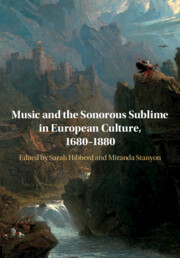Book contents
- Music and the Sonorous Sublime in European Culture, 1680–1880
- Music and the Sonorous Sublime in European Culture, 1680–1880
- Copyright page
- Dedication
- Contents
- Figures
- Musical Examples
- Acknowledgements
- Contributors
- Sonorous Sublimes: An Introduction
- 1 Thunder or Celestial Harmony: French Theological Debates on the Sonorous Sublime
- 2 ‘A Pleasing Rape’: John Dennis, Music and the Queer Sublime
- 3 The Idea of the Past in Eighteenth-Century British Music
- 4 C. P. E. Bach and the Neoclassical Sublime: Revisions of a Concept
- 5 Cherubini’s Médée and Sublime Vengeance
- 6 When Does the Sublime Stop? Cavatinas and Quotations in Haydn’s Seasons
- 7 Counterfeits, Contraltos and Harmony in De Quincey’s Sublime
- 8 The Consecration of Sound: Sublime Musical Creation in Haydn, Weber and Spohr
- 9 Commanding Performances: Opera, Surrogation and the Royal Sublime in 1848
- 10 Wagner’s Sublime Effects: Bells, Cannon and the Perception of Heavy Sound
- Bibliography
- Index
10 - Wagner’s Sublime Effects: Bells, Cannon and the Perception of Heavy Sound
Published online by Cambridge University Press: 30 April 2020
- Music and the Sonorous Sublime in European Culture, 1680–1880
- Music and the Sonorous Sublime in European Culture, 1680–1880
- Copyright page
- Dedication
- Contents
- Figures
- Musical Examples
- Acknowledgements
- Contributors
- Sonorous Sublimes: An Introduction
- 1 Thunder or Celestial Harmony: French Theological Debates on the Sonorous Sublime
- 2 ‘A Pleasing Rape’: John Dennis, Music and the Queer Sublime
- 3 The Idea of the Past in Eighteenth-Century British Music
- 4 C. P. E. Bach and the Neoclassical Sublime: Revisions of a Concept
- 5 Cherubini’s Médée and Sublime Vengeance
- 6 When Does the Sublime Stop? Cavatinas and Quotations in Haydn’s Seasons
- 7 Counterfeits, Contraltos and Harmony in De Quincey’s Sublime
- 8 The Consecration of Sound: Sublime Musical Creation in Haydn, Weber and Spohr
- 9 Commanding Performances: Opera, Surrogation and the Royal Sublime in 1848
- 10 Wagner’s Sublime Effects: Bells, Cannon and the Perception of Heavy Sound
- Bibliography
- Index
Summary
As a lookout atop the Dresden Kreuzkirche during the uprising of 1849, Wagner describes the spectacle of a city in flames, and the acoustic panorama of cannon and gun fire, amid the immense bells pealing just behind his head: ‘a wonderful intoxicating polyphony’. It was also deafeningly loud and conveyed the unfolding violence and brutality below. His willing absorption may seem perverse, yet it invites us to consider ways in which the qualities of lived experience are entwined with auditory effects: the experience of proximate physical danger, the perception of violent sounds, and the vicarious experience of conflict through rhythmically moving sound masses, from regimented columns of insurgent soldiers to the ostinato-based ritual of Grail knights. With Wagner’s experience as a focal point, this chapter investigates the willing abolition of normative categories of experience vis-à-vis the perception of danger. It asks to what extent massed, rhythmic, non-musical sound complexes, viewed within the tenets of the sublime, infiltrate the sonic image of Wagner’s music. By positing cannon and bells as reciprocal signalling devices tethered to the sublime, it also suggests that these material objects perform a dazzling confusion of purposes, simultaneously communicating time, propagating war, staging opera and physically stimulating bodies.
Keywords
- Type
- Chapter
- Information
- Music and the Sonorous Sublime in European Culture, 1680–1880 , pp. 245 - 272Publisher: Cambridge University PressPrint publication year: 2020



